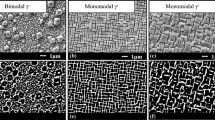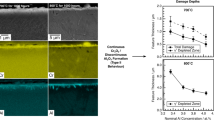Abstract
Mechanically-alloyed Ni-base ODS superalloys currently receive attention for application in future gas turbines because they exhibit outstanding mechanical properties at high temperatures. They also protect themselves against oxidation by forming chromia and/or alumina scales. However, little attention has been given so far to the initial stages of oxidation of Ni-base ODS superalloys, containing Cr as well as Al in considerable amounts. In the current work, oxidation at 1150°C was studied for different holding times up to 200 hr for the commercial materials MA6000 and PM3030 which contain. Al in increasing amounts. MA 754, a chromia former, was investigated as a reference. It was shown that for the potential alumina formers MA6000 and PM3030 the continuity and therefore protectiveness of the secondary Al2O3 at later stages is indeed determined by the initial stages of oxidation.
Similar content being viewed by others
References
T. A. Ramanarayanan, R. Ayer, R. Petkovic, and D. P. Leta,Oxid. Met. 29, 445 (1988).
W. J. Quaddakers, H. Holzbrecher, K. G. Briefs, and H. Beske,Oxid. Met. 32, 67 (1989).
W. J. Quaddakers,Werkst. Korros. 41, 659 (1990).
Material Data Sheet ODS Superalloy, PM Hochtemperatur. Metall GmbH, Frankfurt, Germany, 1992.
R. T. Grimley, R. P. Burns, and M. G. Inghram,J. Chem. Phys. 34, 664 (1961).
C. S. Tedmon Jr., J. Elektrochem. Soc.113, 766 (1966).
D. C. Agarwal, W. R. Herda, and U. Brill,Adv. Mat. & Proc. 10, 42 (1995).
W. J. Quaddakers and K. Bongartz,Werkst. Korros. 45, 233 (1992).
R. Prescott and M. J. Graham,Oxid. Met. 38, 233 (1992).
J. M. Hampikian and D. I. Potter,Oxid. Met. 38, 139 (1992).
F. S. Pettit, C. S. Giggins, J. A. Goebel, and E. J. Felton inAlloys and Microstructural Design, J. K. Tien and G. S. Ansell, eds. (Academic Press, New York, 349 1976).
C. S. Giggins and F. S. Pettit,J. Elektrochem. Soc. 118, 1782 (1971).
J. L. Smialek and G. H. Meier inSuperalloys II, C. T. Sims, N. S. Stoloff, and W. C. Hagel, eds. (John Wiley, New York, 283, 1987).
H. M. Tawancy and N. Sridhar,Oxid. Met. 37, 143 (1992).
G. C. Wood,Oxid. Met. 2, 11 (1970).
P. Kofstad, inHigh Temperature Corrosion (Elsevier Applied Science, New York, 342, 1988).
N. Birks, G. H. Meier, and F.S. Pettit,JOM 12, 42 (1994).
W. J. Quaddakers, H. Schuster, I. Schubert, and H. Nickel, inEurocorrosion 1991; I.Karl and M. Bod, eds., Budapest, Hungary, 251 (1991).
Author information
Authors and Affiliations
Rights and permissions
About this article
Cite this article
Angermann, H.H., Nishi, K., Aono, Y. et al. Evolution of oxides on Ni-base ODS superalloys. Oxid Met 48, 1–39 (1997). https://doi.org/10.1007/BF01675260
Received:
Revised:
Issue Date:
DOI: https://doi.org/10.1007/BF01675260




